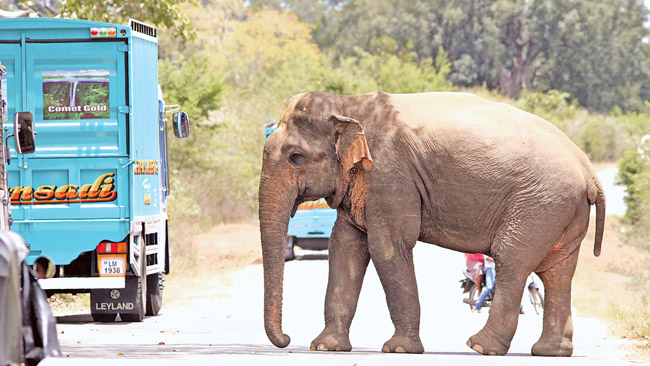
Injured giant
Sri Lanka as a nation has an enormous debt to pay to the wild elephants for safeguarding the areas of the present northern province, north central province, eastern province as well as Puttalam district for seven centuries. During this time, the island’s sovereigns completely abandoned Polonnaruwa, Anuradhapura and the entire Rajarata and shifted the seats of administration and capitals to the western, northwestern and central provinces: Kurunegala, Dambadeniya, Gampola, Kotte and Kandy.
King Parakramabahu the Great ruled for 33 years from 1153 AC to 1186 AC. Unfortunately, he died without issue and 13 sovereigns of whom ten were kings, two were queens and one was a three-month old infant ruled from 1189 to 1214 AC. of them, the only noteworthy sovereign, who was able to maintain the massive network of irrigation works constructed by King Parakramabahu the Great and also uphold the Buddhist traditions which climaxed under the king, was King Nissankamalla. However he could rule only for nine years from 1187 AC, as he died in 1196 AC. Eleven sovereigns followed thereafter in quick succession till 1214 AC, when a foreign despot known as Kalinga Magha wrested authority at Polonnaruwa. He and his depraved troops plundered and destroyed the entire Rajarata. By the end of 21, years of Kalinga Magha’s barbaric rule, there was massive depopulation and the Rajarata plunged into the depths of penury and the jungle crept back to hide all the traces of the former grand civilisation.
It was only the widespread and eternal presence of elephants that prevented travellers, especially from the Arabian peninsula and the Indian subcontinent, who were frequent arrivals to Sri Lanka, from making inroads into the interior inland areas to establish settlements. The wild elephants also safeguarded the Buddhist shrines and various other historical monuments from treasure-hunters and vandals. When the Somawathy Chaitya, where a sacred Tooth Relic of the Buddha is enshrined, was discovered in 1947, its vicinity was full of wild elephants and it has been observed by many that wild elephants visit the Chaitya around midnight to pay respects.
During the British Colonial period, a foreign vandal, who was taking aim to shoot at one of the Buddhist statues at the famous Gal Viharaya at Polonnaruwa, was killed, before he could release the trigger, by an elephant. It emerged suddenly from the forest behind him. These indicate that the wild elephants have been a source of extraordinary protection to the Buddhist places of worship whether they were in ruins or not, since the 13th century.
Army of wild elephants
The profusion of elephants that captain Robert Knox, a captive of the island’s king of Kandy, had encountered during the week of his escapade by fleeing through the jungle along the Malvatu Oya from Anuradhapura to the maritime boundry of the Dutch near Arippu in 1679 gives an indication of the density of the elephant population in the jungles of these areas at that time. The extreme mortal fear created by wild elephants in these jungles was as great as the oppressive fear the people had of the barbaric capital punishments of the ruling autocratic monarchs further down south of the island. It was this army of wild elephants which kept all the unauthorised activities of jungle clearing, settlements, treasure hunting and vandalism at bay.
Reverend Phillipus Baldaeus, a Dutch priest, who was in Ceylon for nine years, published a book titled ‘A true and exact description of the great island of Ceylon’. It was translated from Dutch to English by a Ceylonese, Pieter Brohier, and published in 1960. Out of the nine years, he spent one year at Matara and the rest in Manner and Jaffna districts, where he conducted missionary activities. He refers to elephants abounded in these districts and records a personal encounter with an elephant while travelling between Manner and Jaffna and even condoles the death of the chief of the elephant catchers in the Manner region by an elephant. In his description of the 11 churches built in Jaffna during his tenure, he mentions that the surroundings of the church at Pulopalai was subject to depredations of wild elephants. An illustration of this, depicting a herd of elephants and the wild palm trees felled by them, is also presented in the book.
Pulopalai is in Jaffna close to Elephant Pass. Further in his map of Vanni and Jaffna, the presence of elephants is indicated as extending right up to the boundary of Jaffna lagoon from Kilinochchi.
British colonial era
During the British colonial period, when the forests in wet zone were cleared for planting coffee, tea and rubber, the killing of elephants by shooting occurred in a massive scale. Shooting of elephants also occurred in the dry zone and intermediate zone by irate farmers for the protection of the settlements and cultivations with whatever type of guns they could lay their hands on, licensed or unlicensed, serviceable or unserviceable, imported or locally, turned out. When reading through the accounts of the exploits of shooting of elephants by hunters, who called themselves ‘ sportsman’ the descriptions of dead elephants invariably mention of innumerable gunshot injuries all over the body and these hunters have been the ones who fired the final fatal shots with their modern rifles to kill the elephants. The farmers have at most times shot elephants while perched atop their watch huts, built well above the range of the extended trunks of elephants, on strong trees.
The accounts of the pastimes of these ‘sportsman’ end with the grim tales of butchery for the removal of the forelegs, ears, tails and teeth of elephants for souvenirs as well as umbrella and walking stick stands for the porches of their bungalows. Actually from the commencement of the British colonial era up to now, the elephants have had no respite from being at the receiving end of bullets and suffering, for with the clearing of lands for the Galoya, Udawalawe and the Mahaweli projects, the last of which is still continuing, new colonists, settled in the former elephant habitats, continue to main and kill elephants using more and more sinister ways in addition to shooting.
Dr R L Spittel, the celebrated author, anthropologist and environmentalist of Sri Lanka, sounded these forebodings very succinctly in the editorial of the June 1951 issue of the ‘Loris’, the magazine of the Wildlife and Nature Protection Society of Sri Lanka, when large extents of hitherto elephant habitats were getting cleared for the projects at Galoya and Udawalawe.
The wild elephants are our biggest national asset and deserve a better treatment than being confined to the sixteen national parks and sanctuaries to eke out a living and get shot or electrocuted or die of bomb blasts in the mouth or get run over and killed by vans and trucks or railways or even get their calves stolen from them the moment they step out of the national parks or sanctuaries.
Currently 35 elephant calves, which were harboured in private premises, whose owners did not have valid legal documents to retain the calves, have been sent to the two state run elephant orphanages at Pinnawela and Udawalawe by the relevant authorities. The public are still not aware as to how these calves were procured from the wilds. Because elephants have become sources of easy income today from elephant rides and safaris for tourists as well as hiring out of elephants for religious processions, surreptitious capturing of elephant calves by contract catchers is a very serious threat to the survival of the wild elephants. Incidentally one cannot avoid wondering how elephant kidnappings have happened in such a massive scale in this country which only a few years earlier gained a notable victory over one of the most powerful terrorist organisations of the world.
Tragic consequences
Of the five continents in the world, elephants are found in only the two continents of Africa and Asia. The African elephant is Loxodonta africana and its two subspecies are the ‘Savannah elephant’ (Loxodonta africana africana) and the ‘Forest elephant’ (Loxodonta africana zyclotis).
The Asian elephant is Elephes maximus and there are three subspecies known as the ‘Ceylon elephant’ (Elephes maximus maximus) ‘Sumatran elephant’ (Elephes maximus sumatriana) and the ‘Indian elephant’ (Elephen maximus indice). The ‘Ceylon Elephant’ is found only in Sri Lanka and in the biggest of the Asian elephants.
The Solution to the ‘Elephant – Human-Conflict’ resulting in tragic consequences for both elephants and humans is long overdue. One is inclined to think that the elephants were forgotten entities in the land clearing equations at the planning stage of the mega projects of the Galoya, Udawalawe and the Mahaweli and the solution were from ideas which cropped up later as the ‘elephant problems’ were getting out of hand. Is it not better for us, even at this large stage, to have a sound, far sighted elephant conservation policy which can also be integrated into an economic development policy of the dry zone, which comprises 58 percent of the island’s land mass?
(Source : 18/07/2016 Daily News http://www.dailynews.lk/?q=2016/07/18/features/87795)

Water resources planning key for sustainable climate adaptation in SA: experts

An international conference on climate change and water resources management has concluded that urgent action is needed to ensure South Asia is better prepared to address future climate conditions, including anticipated extremes of flooding and drought.
Part of the World Bank-led South Asia Water Initiative (SAWI), the conference saw participation from over 65 water resource and climate change experts, scientists and policy makers from seven South Asian countries- Afghanistan, Bangladesh, Bhutan, India, Nepal, Pakistan and Sri Lanka – as well as China. Speaking at the opening session, Guest of Honour Dr. SarathAmunugama, Minister for Special Assignments in the Government of Sri Lanka said, “This seminar comes at a very important time, almost all countries represented here face crises of some sort as a consequences of climate change.“
According to research undertaken by IWMI scientists, many areas of Sri Lanka will experience future changes in temperature, rainfall, evaporation and sea level rise. This will affect a range of sectors, including agricultural production of important export crops. Surface and groundwater quality in coastal areas is also likely to be impacted affecting important drinking water supplies. Participants agreed that coordinated responses across all sectors can help to reduce the impacts of changing weather patterns on key sectors, urban centres and the country’s substantial natural heritage.
Three scientific papers presented at the conference highlighted the pressing need for action amid the uncertainty surrounding future water access and availability. Underscoring the need for solutions that can adapt to change and are therefore more responsive to uncertain decision-making environments, Professor Casey Brown from the University of Massachusetts Amherst presented the decision tree framework supported by the World Bank. This framework informs planning of water resources infrastructure using examples from hydropower planning in Nepal and water supply planning in Kenya.
Professor Aris Georgakakos from Georgia Water Resources Institute presented an integrated river basin planning approach used for the Rufiji basin in Tanzania under the World Bank Water Sector Support Project which emphasized smart approaches to develop “no regrets” solutions benefiting communities, agriculture and energy sectors, business and the natural environment,as well as integrating climate change implications.
Other notable experts included Professor Mohan Munasinghe, one of Sri Lanka’s most senior researchers on climate change and a member of the UN’s Intergovernmental Panel on Climate Change. Highlighting the vulnerability of South Asia to climatic fluctuations, he stressed the importance of managing water resources in a manner consistent with the Sustainable Development Goals, suggesting the need for a Sustainable Water Resources Management approach, ‘SWARM’.
Climate change is likely to profoundly impact water supply and demand as well as increase extreme events, such as floods and droughts, underscoring the need for developing effective policy frameworks as well as practical adaptation responses. According to Dr. Rafik Hirji, the World Bank Team leader, “Governments in the region who haven’t yet mandated integrated water resources management (IWRM) are urged to step up efforts to formulate and implement those policies and those with policies in place need to elevate attention to their implementation. Effective planning, development and management of surface and groundwater will be key to ensuring that the resource is protected, conserved, secured and utilized optimally for the benefit of all South Asians.”
Experts voted on series of potential next steps including practical initiatives on public education and awareness raising, initiatives on flood early warning and on climate adaptation and groundwater, ways of addressing ‘non-water’ sectors effectively in tackling water governance challenges and building more substantial regional data and knowledge sharing and capacity building through establishing a community of practice.
The conference was followed by a field visit on July 14,organized by the Ministry of Irrigation and Water Resources Management to areas north of Colombo recently affected by flooding along the Kelani River, and where flood response measures are being undertaken by the government.
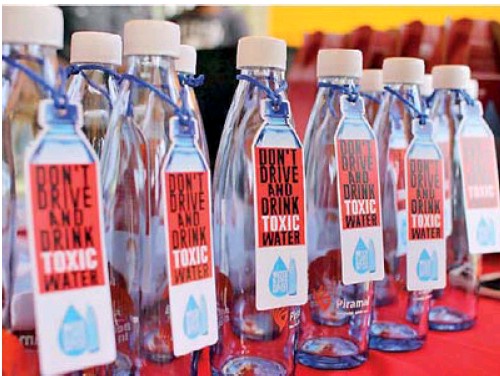
Believers in Glass gives away glass bottles for water storage
The ‘Believers in Glass’ movement, tied up with Piramal Glass Ceylon PLC, is giving away free glass bottles for water storage in vehicles. This was conducted in selected IOC petrol stations recently. The campaign ‘Don’t drive and drink toxic water’ called out to people not to carry water or store water in plastic for long, as plastic in the bottles leach chemicals into the water thus poisoning it.
Piramal Glass Ceylon PLC MD Sanjay Tiwari explained further that as per various global research, mineral water, if stored in plastic bottles, has 27 percent higher Bromates than WHO standards (4 mg in 1 litre is the maximum limit) and also more Chlorites and Chlorates. Another research revealed the presence of harmful elements such as antimony, lead and cadmium in liquids stored in plastic.
When exposed to over 40 degrees Celsius of heat, plastic bottles can leach chemicals such as Bisphenol A (BPA) and Diethylhexyl phthalate (DEHP) into your water, thus making it toxic, whereas glass provides a protective shield against such chemicals. These toxic chemicals may cause a negative effect on your immune system, hormonal imbalance, baldness, asthma in children, diabetes, hypertension, pancreatic malfunction, liver and kidney problems and even cancer.
New research shows that BPA negatively affects the chances of conceiving and results in a higher risk of miscarriages. Antimony leads to heart muscle damage, Cadmium causes respiratory tract infections and DEHP has already been banned in many countries.
All this data means that one should always store water in glass.
The Believers in Glass movement elaborated further on the benefits of using glass. Glass is made from natural raw materials, which are advantageous to our health since the glass has an outstanding barrier that fights and protects against outside influences. Glass is also nonporous and impermeable.
Glass has the capability to withstand extreme heat and cold, this enables glass to prevent any reaction with the contents it holds, while maintaining its freshness and durability. It also helps to maintain the aroma, flavour and freshness of food and does not negatively affect its contents in any way. It is perfect for the long-term preservation of food in its original state.
Besides personal health, there are also environmental reasons to use glass as against other forms of packaging.
Worldwide only one out of five plastic bottles gets recycled, while the rest are either burnt or land filled. Each of these plastic bottles takes about 700 years to decompose naturally.
Plastic bottles end up threatening our wildlife and harming the environment, thus making our world a less beautiful place. Glass on the other hand is 100 percent recyclable which in turn makes it environment-friendly.
A used glass bottle can always be recycled into a new one, because glass is 100 percent recyclable. Every ton of glass that is recycled saves more than a ton of the raw materials needed to create new glass. This proves that glass is very respectful of our environment, reducing landfills and saves energy.
The above launch is in continuation of the movement Believers in Glass, which was launched recently, to create awareness and educate the public to use the right form of packaging.
Piramal Glass Ceylon, as part of its corporate social responsibility, is involved in several activities. One of the major activities is that it collects waste glass from independent waste collectors around the entire island and recycling them. This helps to save energy and natural resources of the country, apart from generating an income for many individuals. Piramal Glass Ceylon has established glass collection centres at all major divisional secretariats, which enables households and corporates to dispose of the waste glass.
To support the above initiative Piramal Glass Ceylon has taken lead to form an association for waste recycling namely ‘Sri Lanka Recyclers’ Association’.
In continuation of its commitment to society and the environment, Piramal Glass Ceylon has supported the Believer in Glass movement and has started its journey of transformation, by not only educating but giving alternate solutions. This launch is just the beginning.
(Source 15/07/2016 Dailly Mirror http://epaper.dailymirror.lk/epaper/viewer.aspx)
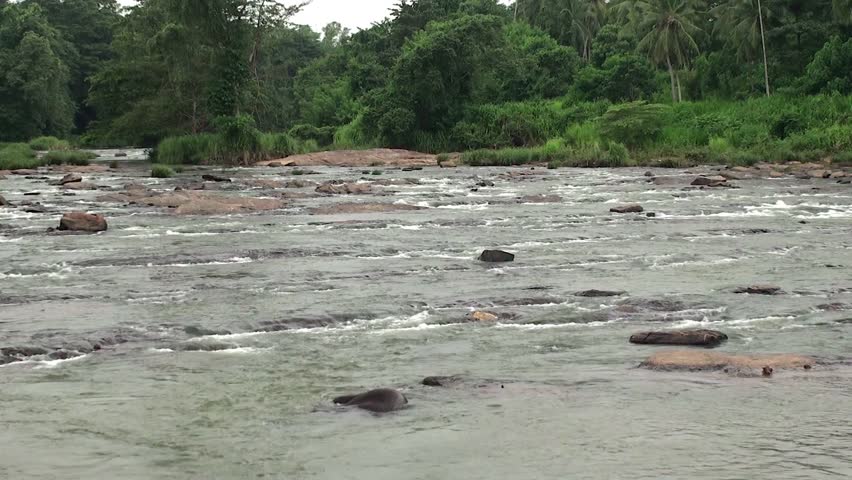
Maha Oya Sand Mining To Affect Millions
(Sand mining at Maha Oya)
The coastal stretch from Negombo to Chilaw has been identified as the most eroded coastline in Sri Lanka by the Coastal Zone Management Plan in 2006, of which between 80 and 85 per cent of the degradation is attributed to exacerbated sand mining in the Maha Oya.
Erosion rate
According to EFL, at certain places such as Katuneriya and Lansiagama, the erosion rate is 12-15m/year. Due to the coastal erosion in Wennappuwa and Nattandiya DS divisions, over one thousand families lost their properties over a 20-year period giving rise to a number of adverse impacts including loss of homes and other properties, and loss of livelihoods. Some of these displaced communities have been living in temporarily built sheds for nearly three years since 2009.
Maha Oya is one of the largest rivers in Sri Lanka, which flows 128 kms across four provinces and five districts. It starts from Nawalapitiya, from the area of Aranayake and falls into the Indian Ocean from Kochchikade, North of Negombo.
More than 1.1 million of population live by the river, harnessing myriad of benefits from the river for their subsistence and livelihood activities. The Maha Oya provides water for domestic and industrial needs to different communities living by the river.
There are 14 National Water Supply and Drainage Board (NWSDB) water intakes along the Maha Oya. Some of the important water users are Bandaranayake International Airport (BIA), Katunayake Export Processing Zone (KEPZ), Kegalle Urban Council, Negombo Municipal Council, Mawanella Pradeshiya Sabha and four other industrial parks.
Bird watching
The downstream of the river is famous among environmentalists, tourists and bird watchers, being one of the tourism hotspots of the country. Hence, continuous river flow and good health of the riverine environment is of vital importance in terms of socio-economic and environmental aspects. The river associated mineral extraction such as sand and clay mining is widespread in the midstream and downstream especially in Kurunegala, Puttalam and Gampaha districts, with river sand being one of the essential ingredients in the construction industry.
The Maha Oya has become a well-known source of high quality river sand. The annual sand requirement of the country is nearly 8.5 million cubes a year as recorded in 2010 with an increase of 5-10% per annum. Quite a significant quantity of Sri Lanka’s fine sand requirements has been supplied from Maha Oya since 1970’s, said EFL’s Chief Operations Officer Chamila Weerathunge.
With the free economic policies and subsequent boom in the construction industry, stresses on the Maha Oya as a source of sand has been gradually increasing over time. Since the late 1980s, the sand mining in the Maha Oya and clay mining in the hinterland have been exacerbating, giving rise to a number of environmental and socio-economic problems.
Most devastating
The most devastating impacts not only confine to the riverine environment, but also the coastal environment that has been subject to severe degradation. The Maha Oya transports sand to nourish the coastline from Negombo to Chilaw.
The Coast Conservation Department has spent millions of rupees to stabilize the coast against ongoing erosion.
The river itself is subject to severe degradation due to river sand and clay mining. The most devastating impacts include: River bank erosion and land degradation due to erosion and inland mining; Lowering of the water table causing problems in water accessibility; Salinity intrusion to the river and other fresh water systems due to lowered river bed and water table; Loss of biodiversity and associated impacts on tourism and recreational value of the river; Impacts on the livelihoods and subsistence of the communities. There are more than 1,000 traditional miners along the Maha Oya River, but the engagement of the powerful business groups in this industry causes threats to their livelihoods.
These business groups carry out illegal mining using heavy mechanical equipment such as long arm backhoes and motor boats which have been completely banned since 2004. Mechanized mining causes more damage to the riverine environment than traditional artisan mining. The extraction rate of the sand is far higher than that of artisan mining causing bank erosion and depletion of sand deposits.
Integrated approach
A project implemented by the Environmental Foundation Limited (EFL) in collaboration with the Geological Survey and Mines Bureau (GSMB) and Open University of Sri Lanka (OUSL) with funding of the Mangroves of the Future Initiative adopted an integrated approach in conservation of the riverine environment in order to increase the resilience of coastal and riverine communities.
Under this project, the maps developed on the distribution and area occupied by mined pits are: Figure 01: Eroded river bank of the Maha-Oya, 2011 shows the level of degradation of the Environmental Foundation (Guarantee) Limited, No. 146/ 34, Havelock Road, Colombo 5, Sri Lanka; Figure 02: A map of mined pits along the downstream of the Maha Oya; Figure 03: A river meander of the Maha Oya – Mukkama, May, 2016 land in the hinterland of the river. A significant number of land owners along the river lost their lands either partially or completely due to erosion of river banks. The change of land use and land degradation in the riverine environmental causes degradation of ecosystems impacting the provision of ecosystem goods and services to the communities who are dependent on them.
The fish diversity and the abundance were impacted adversely jeopardizing the livelihood of freshwater fishermen. Aggravating these conditions, untreated effluent discharge from several industries deteriorates the quality of the water in the Maha Oya preventing communities using water from the river. In Godigamuwa area only, more than 100 house owners were forced to abandon their domestic wells due to drying up or dig the existing wells further to access water.
Salinity intrusion
Salinity intrusion to the river has caused severe problems in treating this water at Bambukuliya Water Intake operated by the National Water Supply and Drainage Board (NWSDB). In 1984, the NWSDB constructed a salinity barrier to avoid salinity intrusion through the upstream water intake with the expenditure of SLR 200 million. The bridge at Badalgama is under threat of collapse due to the eroding river banks in the vicinity. In addition to that, the road driven from Thoppuwa to Madampella is subject to erosion in the areas closer to river.
These impacts stimulate the thinking that value of sand extracted from the Maha Oya has a higher cost of production than the benefits it garners to the construction industry. Different institutions including Geological Survey and Mines Bureau, Department of Irrigation and Central Environmental Authority are responsible in addressing these issues, but these problems have been persisting for decades up to date due to inadequate attention by these institutions.
It was suggested that these government stakeholders unite to develop and draft an implementable management plan to mitigate the impacts already taking place and prevent the detrimental impacts which would take place in the future. And subsequently in the year Environmental Foundation (Guarantee) Limited, No. 146/ 34, Havelock Road, Colombo 5, Sri Lanka 2015, the Geological Survey and Mines Bureau drafted the Management Plan for Maha Oya with the participation of wider stakeholders along the river. The ongoing Maha Oya River Management Plan is expected to regularize mining activities, restore degraded areas, monitor illegal mining and effluent discharges whilst harvesting river sand in a sustainable manner. However, with the visits carried out to the downstream of the river in May 2016, it is highly questionable that the Management Plan is taking the right direction in conserving the riverine ecosystems for the future generation.
Disclaimer: Information in this article has been directly obtained from the Department of Irrigation, Geological Survey and Mines Bureau, National Water Supply and Drainage Board, Roads Development Authority, Coast Conservation Department, during the years of 2009-2011 for the implementation of the Mangroves for the future funded project on ‘Increasing the Resilience of Coastal and Riverine Communities to Climate Change and Other Threats by Conserving the Ecosystems of the Maha Oya and Other Wetlands’.

World Bank supports Sri Lanka water management to adapt to climate risks
The World Bank will help the Sri Lankan government to develop its water management institutions to adapt to the challenges posed by climate change, a senior official said.
The south Asian region is subject to extremes of floods and droughts which will worsen with climate change, said Rolande Pryce, Operations Advisor in the Colombo office of the World Bank Group.
These climate events will threaten water resources, agriculture and many coastal cities, she told a regional forum of scientists and policy makers from across South Asia in Colombo to discuss how water management can better respond to future climate adaptation needs. Risks are increasing sharply with climate change, Pryce said, noting how floods have ravaged the capital Colombo at least five times in the last 10 years.
“Climate change risks and water management are strongly linked in Sri Lanka,” Pryce said.
The 2017-20 World Bank country program identifies water resources development and management as continuing priorities for Sri Lanka in the light of increasing climate-related risks, she said.
The World Bank has several programs supporting Sri Lanka’s water sector including those for dam safety and water resources planning, urban flood control in Colombo and key secondary cities like Kandy, Galle and Jaffna, and water supply and sanitation. “In future, we will help the government to develop water management institutions to adapt to the challenges brought about by climate change risks,” Pryce said. Rising sea levels will also put more pressure on ground water resources, Pryce told the forum, organised by the International Water Management Institute and the World Bank, through the South Asia Water Initiative (SAWI) Technical Assistance as a follow-up to the global climate agreement in Paris in December 2015.
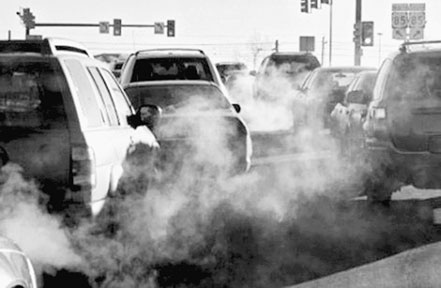
Do we really care about the air we breathe?
Air pollution is currently acknowledged as a threat to public health in most developed and developing countries in the world. According to the World Health Organization (WHO) air pollution is identified as one of the largest global health risks, causing approximately seven million deaths every year.
This threat has been recognized due to evaluations conducted to measure the air quality levels as well as the extent of the pollution. However, in Sri Lanka such significance is not attached to counteract the harmful effects of air pollution, which is increasingly becoming a great menace to the country.
Therefore, at present, based on these regrettable conditions, creating awareness on how air pollution has become a national threat as well as a public health hazard to the country, has taken precedence as a paramount concern.
Issues with vehicles and traffic congestion
Speaking to Ceylon Today on this issue Emeritus Professor of Chemistry, University of Peradeniya and Visiting Senior Professor of Chemistry, Institute of Chemistry, Prof. O.A. Ileperuma, shared his expert opinion. He said: “Air pollution is a serious problem here due to the increasing number of vehicles and also traffic congestion as there is more pollution from vehicles when they move slowly due to traffic conditions. In addition due to our energy demands we are now using coal and diesel to generate 50% of our energy. We are burning coal at Norochcholai to generate power which makes the situation worse.”
“In response to this in 1998 when President Premadasa was in power, he had plan called the Clean Air Action plan to provide clean air for Colombo by the year 2008. There were 47 steps proposed but only three have been implemented successfully. These three are reducing the sulphur content in diesel, removing lead from petrol and air quality monitoring.”
According to the Central Environment Authority (CEA) based on the available records regarding the air quality monitoring status in Sri Lanka till 2012, the values of ambient Particle Pollution, Particulate Matter (PM)-10 level in Colombo has constantly exceeded the WHO guideline value.
Need to repair air quality stations
The Professor discussed about the air quality stations which enable this process of monitoring the air quality levels in Sri Lanka. He said that with the assistance of the World Bank these stations had been installed back in 1996. These included a peak station at the Colombo Fort Railway Station and a background one at the premises of the Department of Meteorology in Bauddhaloka Mawatha.
Unfortunately the air quality levels in the country cannot be measured by these stations at present, as they have been dilapidated and are currently in disrepair. According to Prof. Ileperuma these stations have only worked till 2003 and from that year onwards there has been a general lack of awareness about the air quality level in Sri Lanka. The only working air quality monitoring station is a mobile one which can be carried, to be used before starting any major industry or constructions.
Assurance of future reparations
However, the Chairman of the CEA Prof. Lal Mervin Dharmasiri told Ceylon Today that the necessary equipment has now been purchased to repair the peak air station at the Colombo Fort Railway Station.
“Though I cannot give the exact time I believe that, we will be able to repair this station within a month or so. We can also fix the LED panel so that it can properly display what the values are. So if the air quality is below the internationally accepted guideline value, the light will be green. If the light is red that means the air quality level is at a dangerous level. So after this particular station is fixed, the public will be able to easily get an idea about the air quality level.”
Air pollution in Kandy
According to various researches conducted, the level of pollution in Kandy is even higher than that of Colombo. As mentioned in a research work by Prof. Ileperuma and Dr. T.L.J.C. Siritunga on Air Pollution and Health published by the US Agency for International Development (USAID) in Colombo, “recent results show that the City of Kandy is very heavily polluted and the level of air pollution has reached dangerous levels. The degree of air pollution in Kandy is higher than in Colombo because Kandy is situated in a valley between two mountain ranges. In Colombo, more pollutants are formed but they get dispersed owing to the flat terrain and due to the action of the sea breeze.”
Prof. Ileperuma said that he has been personally been involved with monitoring the air quality in Kandy from 2000-2005. He said that when comparing the level of air pollution of the two cities, it was discovered that air pollution in Kandy is two to three times higher than that of Colombo.
Diesel fumes can cause cancer
In 2012 the International Agency for Research on Cancer (IARC), which is part of the WHO announced that they have reclassified diesel exhaust as a definite carcinogen, putting it in number one category.
“The fumes from diesel carry cancer causing compounds. There is definite evidence that diesel fumes can cause cancer,” the Professor also added.
Fine particles can be threatening
Prof.Ileperuma also said that the major air pollutants are emitted from factories and power plants. One of these pollutants is fine particles. He said that these cannot even be seen by the naked eye, can easily go into the lungs and can cause asthma, bronchitis, pneumonia and other respiratory diseases.
Blast at the Salawa Army Camp
The Professor described the blast at the Salawa Army Camp in detail and said that due to this explosion a large amount of debris will go into the atmosphere in the form of fine particles. So, generally, these are very similar to the ones produced by motor vehicles due to air pollution, but they are very concentrated and occur on a large scale. However, he assured that natural removal mechanisms will be operated by the environment, so that due to the gravity and the rain these fine particles will definitely come down. “I recommend wearing a face mask in such a situation,” he added.
Passive smoking
Prof.Ileperuma also undermined the popular notion of passive smoking being more dangerous than the smoker himself by saying, “it is the particles you find inside the smoker; it is only the vapours that go into the passive smokers. Passive smoking is however very harmful for pregnant women and children.”
Dangers posed by COPD
The Chronic Obstructive Pulmonary Disease (COPD) is one of the most dangerous diseases, which usually occurs in people who are heavy smokers, due to continuous smoking for 10-20 years. However, the Professor said that the situation has turned dire at present as there were some cases reported even among school girls in Kandy because of the air pollution due to heavy traffic.
“Some children as young as 12 years are getting this and it is very likely it is due to the air pollution. Our lungs generally grow till we are about 15 years of age. When children are exposed to air pollution the lung tissues get damaged and after that they do not recover. As a result of this, they have to be in medication, probably, throughout their life. So this is a very serious situation,” he added.
Proposed solutions
The Professor said that the issue with traffic congestion can actually be tackled. He proposed that when there is a lot of traffic he would recommend people to use a face mask with an activated carbon filter.
He also said that he had already proposed to make the two roads leading to Peradeniya in Kandy one way.
“Opening the road in front of the Sri Dalada Maligawa can improve the public transport system. Also long distance buses should not come to the city, they should start from the suburbs. The government can also take sufficient measures to control the number of three-wheelers in the country because they not only heavily contribute to traffic congestion but are also highly polluting.”
Dangers of indoor air pollution
According to the WHO indoor air pollution in Sri Lanka is largely a result of burning solid fuels (biomass or coal) for cooking. Firewood is used as the principal type of cooking fuel in many households in Sri Lanka. Therefore, women and children are at a higher risk of contracting diseases due to household air pollution. According to the findings of the WHO, this leads to a large proportion of the total number of deaths from ischemic heart disease, stroke and lung cancer. It also leads to a number of reported COPD cases in women compared to men. In Sri Lanka, 56 per cent of an estimated 230 child deaths due to acute lower respiratory infections are attributable to household air pollution (WHO – 2012)
Adding to this Professor Ileperuma said: “These old ladies who have been cooking in these kitchens for years get lung cancer. Normally, we attribute lung cancer to heavy smoking in men but this is due to the firewood. Cooking is usually done in a small room with a small window. Generally, while the husband and children are enjoying their time in an airy room, the mother will be cooking in a congested kitchen. What can be done, as a solution, is to cook in an open air kitchen, like back in the old days, with adequate ventilation.”
Air pollution certainly plays a significant role when it comes to health concerns. However, it only comes to the centre of attention when unfortunate incidents such as the blast at the Salawa Army camp occur. So it will only be discussed during that particular time. Nevertheless, air pollution is a real threat and a public menace which affects people on a daily basis. As a result proper and effective measures need to be taken to sufficiently counter this ultimate health hazard.
(Source : 12/07/2016 Ceylon Today http://www.ceylontoday.lk/print20160321CT20160630.php?id=3233)
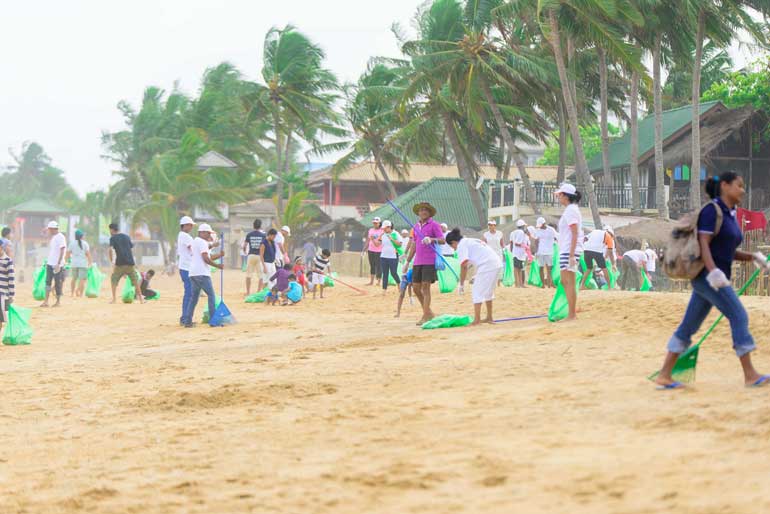
Many volunteers to clean-up Mount beach
Sri Lanka’s revolutionary flip-flop brand “Waves” brought together their employees and volunteers from all walks of life to stage a pioneering corporate social responsibility on Mount beach on June.
The beach clean-up was held to commemorate “World Flip Flop Day” which falls on the third Friday of June every year. Waves” initiated the annual “World Flip Flop Day” celebrations in Sri Lanka last year. Being a brand inspired by the beauty of Mother Nature itself “Waves” initiated the beach clean-up to ensure that beauty is protected for future generations.
The beach clean-up commenced at 7:30am and more than 150 volunteers cleared a 2km stretch of the Mount Lavinia beach of all debris brought in by the waves and garbage left behind by the general public. Many of the volunteers were drawn in through a social media campaign that was widespread especially among the youth who are also the target audience of the brand. Families, groups of friends turned out in their numbers to help in this worthy cause and “Waves” is looking forward to extending this endeavor to other parts of the island as well. –
Source12/07/2016 Daily Mirror : http://www.dailymirror.lk/112334/-Waves-gather-many-volunteers-to-clean-up-Mount-Lavinia-beach#sthash.f3iQWsjk.dpuf
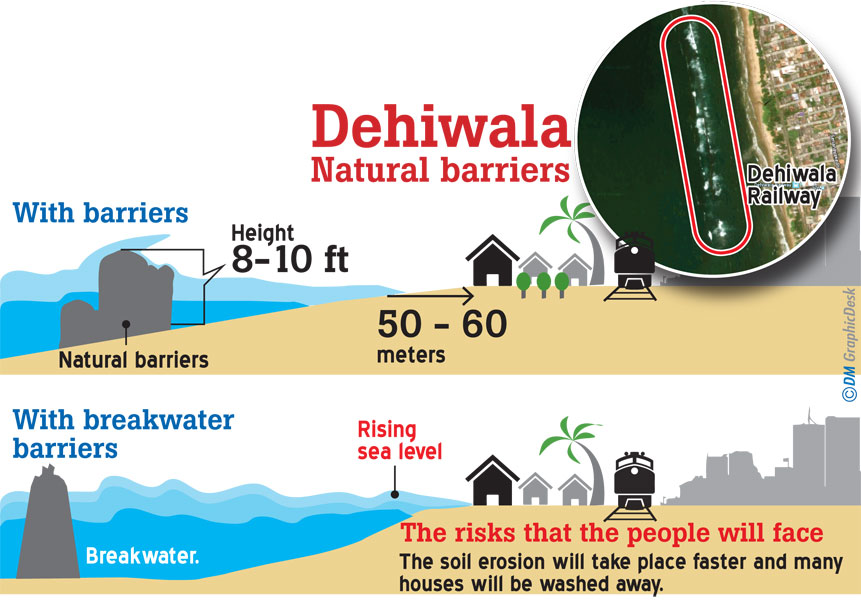
Removal of natural reef after submission of EFR
An Environmental Feasibility Report (EFR) is being drafted by the Minister of Fisheries and Aquatic Resources Development requesting the removal of the natural reef which claims to hinder the Dehiwela coastal line and to build a breakwater.
Minister of Fisheries and Aquatic Resources Development Mahinda Amaraweera has requested for this report and after inspection, the Minister has suggested removing the reef and building a breakwater. However, Mr. Amaraweera has also pointed out the risks that the people will face once the reef is removed. Therefore soil erosion will take place faster and many houses will be washed away.
Once the report is submitted the Ministry will be allocating funds to remove the reef and to build a breakwater and allow the fishermen to engage in their activities. Eminent environmental expert and systems ecologist Dr. Ranil Senanayake said that if this breakwater is removed Colombo will be losing its last environmental protection against the rising of the sea level. “The politicians don’t understand the gravity of its impact after it’s removed. For all these years, how did these boats leave to the sea? Why do they suggest that it should be removed all of a sudden? This is completely ridiculous and if future there will be many adverse impacts on climate change if such an action is being taken.”
Aruna Roshantha of the All Ceylon Fisheries Union said that removing the natural breakwater is not a wise thing to be done. “Fishermen too have their own experiences. If they claim it to be a barrier for them, then the authorities should ensure that they develop favourable conditions for the fishermen to do their fishing. Some of them do fishing during the night and during the days of rough tides, there could be an added risk. According to the fishermen this reef has caused many deaths while on their voyages and has imposed a huge risk on their lives. So far 6 fishermen have lost their lives as a result of their boats hitting the reef and eventually capsizing. However, the Daily Mirror also learned that over the years, the fishermen have been taking their boats out to the sea through a place named ‘kadamaththa’, a U-shaped inversion that has been designed for this purpose. Yet, during the night fishermen usually forget where they have to leave from and at times they are under the influence of alcohol.
A few days back a protest was held by a group of fishermen blocking the railway lines in Dehiwela and requesting the authorities to remove the reef that is obstructing their day-to-day activities. The issue was taken in to consideration by the Minister two months ago and after his visit to the area he has decided to remove the reef and build a breakwater to reduce the rising sea level. A meeting will be held today at the Ministry to discuss about the removal of the reef with the presence of the Minister and the fishing community
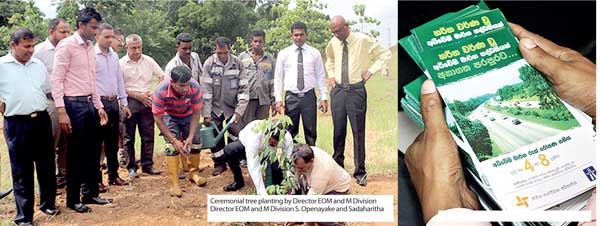
RDA announces Highway Tree Planting Week
The Road Development Authority (RDA) in its efforts to reinforce sustainable development has identified an opportunity to plant trees on the wayside of the Southern Expressway.
At the invitation of Expressway Operation Maintenance and Management Division of the RDA, Sadaharitha Plantations Limited jointly launches a Highway Tree Planting Week and has offered 100 aquilaria plants. The tree planting activities took place in selected locations of the Southern Expressway from July 4 – 8, 2016. Marking this event plants were distributed to the Divisional Executive Engineer Offices at the Galanigama Expressway Interchange Office premises on Monday, July 4.
“Since 2010, the RDA has added greenery on the main roads and city roundabouts and isles. Today we have overcome a challenge in reforesting the Southern Expressway in an aesthetically pleasing manner. Our goal is to plant 50,000 trees in the RDA-owned properties situated on the wayside of the highway,” Director EOM and M Division Expressway Operation Maintenance and Management Division S. Opanayaka noted.
Drawing attention to the significant value of the project Sadaharitha Plantations Ltd Chairman Sathis Navarathne added, “We are more than happy to be part of this great effort. At Sadaharitha Plantations LTD we support efforts of bringing down carbon footprints every way we could, trees and forests are the most vital weapon we have against climate change.” Further elaborating on the importance of reforestation, University of Sri Jayewardenepura Forestry and Environmental Sciences Department Senior Lecturer Dr. Upul Subasinghe explained the importance of adopting to green economy concept using commercial valuable trees. Residents around the Galanigama area, Opanayaka, Nawarathne and Dr. Subasinghe graced the event. See more
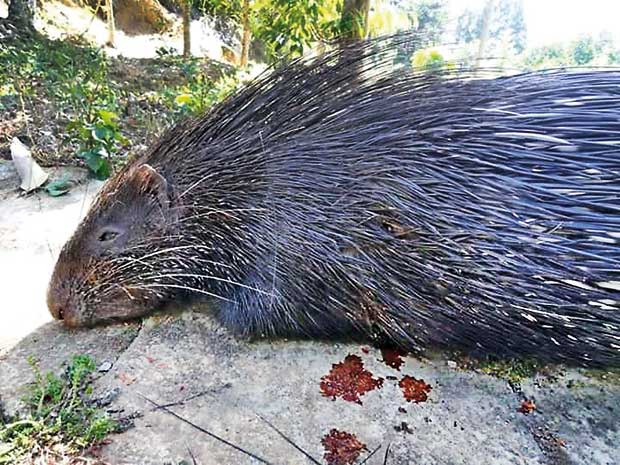
Animal cruelty, weapons and national security
Photos of animal torturers go viral on social media: Animal cruelty, weapons and national security –
Animal cruelty, be it torture, slaughter or even caging for that matter has become a growing concern from around the world. At a time when animal rights activists have started voicing their concerns about allowing animals to coexist with humans, it wasn’t before long that social media revealed footage of a group of people staring at a tortured sea-eagle. This was followed by a man holding a dead peacock with an air rifle in his hand whose wife was giving out numerous excuses to prove that the husband wasn’t guilty. Several months afterwards, quite shockingly, social media again succeeded in ‘naming and shaming’ a group of people who have been killing and torturing rare and endemic species of animals in the wild, for meat and for sheer thrill. In order to shed light on this latest incident, the Daily Mirror spoke to a few interested parties who voiced out their concerns.
These suspects can be arrested without a warrant : Jagath Gunawardena
Environmental lawyer and Attorney-at-law Jagath Gunawardena said that whatever the suspects have been doing were offences under the Flora and Fauna Protection Ordinance. “For example, the barking deer is a strictly protected mammal and just for killing one of them, these suspects can be arrested. The other mammals are categorized as protected mammals but since they are offences, they can be arrested without a warrant. Another thing is the fact that these people have been using air rifles and spearguns which are not being mentioned in the Firearm Ordinance. Even the use of projectiles has not been specified. Therefore it has become easy for people like these suspects to kill animals in the wild without any objections. I suggest that it’s high time that the Firearm Ordinance is duly amended to include these weapons and ensure that all life is ultimately being protected. I also believe that many sophisticated people kill animals and engage in this kind of behaviour for their own entertainment and thrill.” He further stated that there are limitations to killing animals such as wild boars and porcupines. “Although they are listed as non-protected mammals there are limitations to kill them. They can only be killed within a person’s personal property. They cannot be killed during the night time, in a forest, near a waterfall etc. Also there are 8 non-protected mammals, 5 non-protected reptiles and 5 birds. But in whatever the case their flesh cannot be traded.
Excellent way of highlighting animal cruelty : Iromi Salgado
Speaking to the , Committee member of the Animal Welfare and Protection Association (AWPA) Iromi Salgado said that it was an excellent way of highlighting the cruelty that people wouldn’t otherwise have known. “If social media could be used this way it can really open the eyes of the public. Many people wouldn’t have known that these kinds of incidents actually take place. Although this incident had taken place several years back, I am happy that the authorities were able to get hold of the culprits. Animals are a part of our nature and we humans should start to coexist with them.”
“If social media could be used this way it can really open the eyes of the public”
Many people use air rifles to protect their cultivations : N. G Panditharathna
In his comments to the , N. G Panditharathna, Additional secretary, Civil Security and Development division at the Ministry of Defence said that people are allowed to import air rifles. “It is not a fire arm under the act and therefore many people use it in their cultivations. These were issued for coconut planters to use in their cultivations to protect them from animals such as monkeys. Once a dealer is registered under the agriculture department or the Coconut cultivation board, he can import these air rifles and distribute among their farmers. Humans cannot be killed unless shot from a close proximity. Usually animals are aimed at within a distance of 50m and this distance has little effect on killing the target.”
“These were issued for coconut planters to use in their cultivations to protect them from animals such as monkeys”
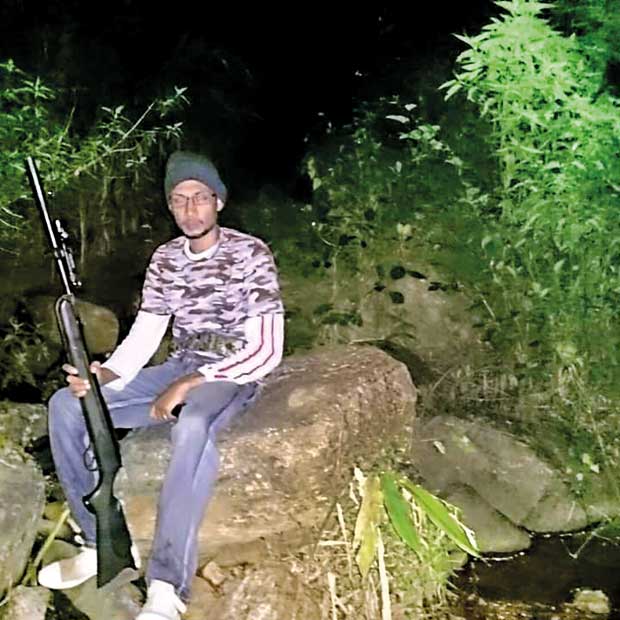
Anybody can possess air rifles without permits : Gamini Jayawickrama Perera
Speaking to the , Minister of Wildlife and Sustainable Development, Gamini Jayawickrama Perera 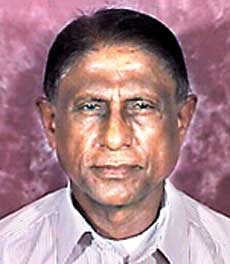 said that all suspects have been arrested and are being questioned. “No permits are needed to possess air rifles in Sri Lanka and this is starting to become a menace now. Anybody can get a stock of air rifles and even start shooting people. Why they use air rifles is due to the fact that it doesn’t produce any sound when killing a target. These people have killed rare species of animals as seen from the photos. We have to start respecting wildlife and treasure our flora and fauna.”
said that all suspects have been arrested and are being questioned. “No permits are needed to possess air rifles in Sri Lanka and this is starting to become a menace now. Anybody can get a stock of air rifles and even start shooting people. Why they use air rifles is due to the fact that it doesn’t produce any sound when killing a target. These people have killed rare species of animals as seen from the photos. We have to start respecting wildlife and treasure our flora and fauna.”
“No permits are needed to possess air rifles in Sri Lanka and this is starting to become a menace now”
The use of these weapons should be banned : Sagarika Rajakarunanayake
In her comments director of Sathva Mithra group and animal rights activist Sagarika  Rajakarunanayake said that it was high time that these weapons were banned from use. “We need to find out who are purchasing these weapons and also who are selling them. It has been a horrible sight to see animals being tortured before they are being killed. The entire line of activity has to be traced because this is not the first time that such an incident took place.”
Rajakarunanayake said that it was high time that these weapons were banned from use. “We need to find out who are purchasing these weapons and also who are selling them. It has been a horrible sight to see animals being tortured before they are being killed. The entire line of activity has to be traced because this is not the first time that such an incident took place.”
“We need to find out who are purchasing these weapons and also who are selling them”
Statement by Police Media Unit
According to a statement released by the Police Media Unit it mentioned that these suspects were residents of Panwila, Kandy and this incident had occured five years ago at St. John’s Estate in Madulkelle.
Six suspects in connection to the incident were arrested on Saturday and Sunday. Two air rifles, pellets and a gun have been taken into custody. The suspects were between ages 22 and 42 and they were produced at the Teldeniya Magistrate’s Court on Sunday for further investigations.
Expose by a wildlife expert
A wildlife expert who wished to remain anonymous told the Daily Mirror that air rifles were issued a few years back to coconut planters to protect their cultivations. The air rifles were used to chase away monkeys and many of them had been distributed at the time. “However the method of killing is immaterial because animals such as the barking deer are endemic species and are strictly protected under the Flora and Fauna Protection Ordinance. These air rifles have now become more powerful because the barking deer is the size of a dog.”
In order to clarify this information the Daily Mirror tried to contact the Minister of Plantation Industries, Navin Dissanayake but learned that he was currently overseas and several attempts to contact Deputy Minister of Plantation Industries, Wasantha Lakshman Perera failed.















